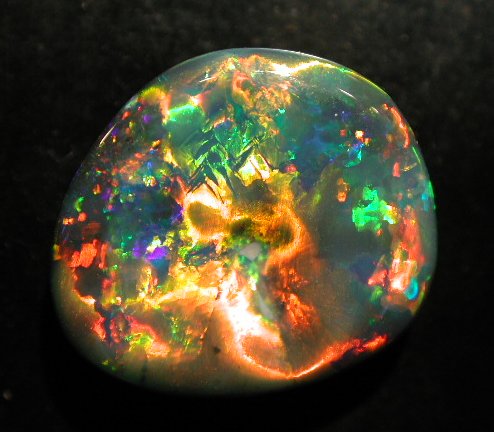
TRIVIA FUN FACT:
The opal is one of the few minerals which can be extracted economically by a miner working alone.
exerpted (from an article by Robert Hughes)
Coober Pedy, the Opal capital of Australia, is about 525 miles north-northwest of Adelaide. You fly there on a little 19-seater plane that stops first at a uranium-mining town called Olympic Dam, a cluster of machinery and huts in absolute flatness--red desert all around. As soon as you get out of the plane (which has to refuel), you are assailed by millions of flies. The fly biomass of central Australia must be 10 times the biomass of humans or kangaroos. You at once start doing the irritable wave of the hand known as the outback salute. The flies crawl into your nostrils, eyes and ears, and when you get back in the plane, they fly in clouds into the cabin, so that the pilot takes out a can of powerful insecticide--"Jeez, this is going to smell really putrid," he cheerfully announces--and sprays them down. Then you take off. Forty minutes later, you land in Coober Pedy, with dead flies in your lap.
Coober Pedy is Aboriginal for "white fella down a hole." Opals were discovered here, lying on the surface, by a 14-year-old boy back in 1915. He was looking for water but instead kept tripping over the "floaters," as surface opals are called. Few floaters are seen now; the opals are all underground, embedded in deep layers of soft sandstone. This whole area, millions of years ago, was ocean floor. So it is relatively easy to mine, and since opal mining is entirely an individual business, like California gold mining back in 1849, it has never been industrialized.
Indeed, it can't be. The big mining companies--which the opal miners hate, along with the government and the cops and the tourists--have never devised a profitable means of detecting or extracting opals. It's handwork. You just stake a claim and start digging. Sounds simple, but the trouble is that none of the conventional geological spotting techniques apply. Opals don't react chemically with the stone matrix around them, and they don't leave the "traces" that gold or diamonds do. So it is a matter of digging and digging and digging. One spot is as good as another; the chances are always essentially the same. You can drill or pick into one spot on the rock wall and find nothing or go in 6 in. away and hit a "pocket," or lode, of opals that could be worth $100,000.
Or--and the miners with whom I spent a night drinking in the clubhouse of the Coober Pedy Golf Club are full of stories like this--you can place an explosive charge, set it off and find that you've blown a quarter-million bucks' worth of opal to worthless dust, the texture of coarse sugar, because you didn't know it was there. Then you just go and have a drink. Or two.
Opal is a silicate fossil. It comes in "shells"--seashells originally, for this whole desert was once a vast inland sea--or more rarely in "pipes," or tubes, the fossilized backbones of archaic freshwater squid. The paradox of the stuff is that although it is so brilliantly colored, it has no color of its own. It's a solid diffraction grating, and the color you see is the light dispersed and reflecting through it. John Smart, the miner in whose mine we filmed, waxes reflective about this. "The opal's just a bloody illusion. It's as though you're spending your life down here digging for something that doesn't actually exist."
